(a) Photosynthesis is controlled by enzymes ; the enzymes are denatured at high temperature; hence
Decrease in product formation. (2 mks)
(b)(i) The rate of product formation is low and constant; enzymes are inactive at low temperature;
(ii) Rate of photosynthesis is high and constant;
This is the optimum temperature for the enzyme activity; (4 mks)
(c)(i) Light intensity / carbon (iv) oxide; (1 mk)
(ii) Oxygen / glucose / starch;
sharon kalunda answered the question on May 27, 2019 at 12:33
-
The diagram below shows a model of the nephron of a mammalian kidney.
(a) Which parts of the nephron are represented by the:
(i) Syringe?
(ii) Perforated rubber...
(Solved)
The diagram below shows a model of the nephron of a mammalian kidney.
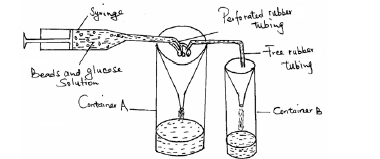
(a) Which parts of the nephron are represented by the:
(i) Syringe?
(ii) Perforated rubber tubing?
(iii) Free rubber tubing?
(b) Name the type of filtration taking place within the perforated rubber tubing.
(c) What would happen to the contents of the syringe if its handle was slowly pushed forward? Explain.
Date posted:
May 27, 2019
.
Answers (1)
-
The picture below shows series of beaks in birds.
a) State the type of evolution that may have led to the emergence of the different beaks...
(Solved)
The picture below shows series of beaks in birds.
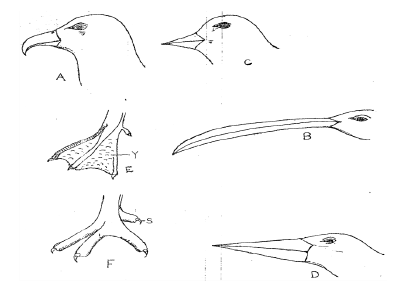
a) State the type of evolution that may have led to the emergence of the different beaks shown on the pictures above.
(b) Name the type of evolution structure represented by the beaks shown on the pictures above.
(c) Observe the pictures carefully. From your observations, what features are responsible for the different types of beaks?
(d) Suggest the type of food likely eaten by birds whose beaks are shown in pictures A, B, C and D.
(e) Briefly state how beak shown in picture A is adapted to feeding.
Date posted:
May 27, 2019
.
Answers (1)
-
You have been provided with photographs of specimens labelled Q1, Q2 and Q3. Examine them.
a) By using observable features only, state the phylum and class...
(Solved)
You have been provided with photographs of specimens labelled Q1, Q2 and Q3. Examine them.
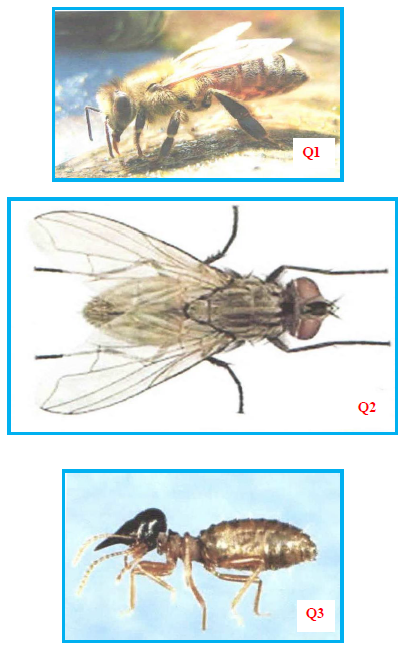
a) By using observable features only, state the phylum and class to which the specimens belong. By using the three specimens, give reasons for each case.
(a) Phylum
Reasons
(b) Class
Reasons
(c) Using observable features only, give three differences between specimen Q1 and Q3.
(d) (i) Apart from locomotion, state the other role of the hind limbs of specimen Q1.
(ii) How are the hind limbs of specimen Q1 adapted to perform role named in d (i) above.
Date posted:
May 27, 2019
.
Answers (1)
-
Study the photographs below and answer the questions below.
(i) To which phylum does organisms x,y and z belong to.
(ii) Name the classes to which...
(Solved)
Study the photographs below and answer the questions below.
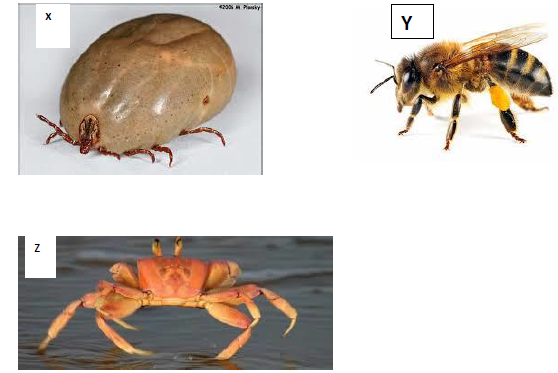
(i) To which phylum does organisms x,y and z belong to.
(ii) Name the classes to which X, Y and Z belongs to.
(iii) Give two important economic roles of specimen Y.
(iv) Give three harmful effects of specimen X to animals.
(v) With reasons identify two modes of locomotion of specimen Y .
Date posted:
May 27, 2019
.
Answers (1)
-
Describe the effects of the various abiotic factors in a terrestrial ecosystem to plants.
(Solved)
Describe the effects of the various abiotic factors in a terrestrial ecosystem to plants.
Date posted:
May 27, 2019
.
Answers (1)
-
Describe the role of the mammalian liver in carbohydrate metabolism.
(Solved)
Describe the role of the mammalian liver in carbohydrate metabolism.
Date posted:
May 27, 2019
.
Answers (1)
-
In an experiment, lactic acid concentration was measured before, during and after exercise to determine the effect of exercise on the concentration of lactic acid...
(Solved)
In an experiment, lactic acid concentration was measured before, during and after exercise to determine the effect of exercise on the concentration of lactic acid in blood. Study the data obtained and use it to answer the questions that follow.

a) Plot a graph of the concentration of lactic acid against time using a suitable scale. (6 marks)
b) From the graph:
i) Determine the period of exercise.
ii) Explain
c) i) Determine the time when oxygen debt incurred.
ii) Explain
d) i) The duration it took to pay back the oxygen debt
ii) Explain
e) Plot a hypothetical curve for oxygen intake during the experimental period on the same axes.
f) Why does lactic acid level usually continue to rise in the blood after the exercise ceases?
g) State two of effects of lactic acid on tissues.
Date posted:
May 27, 2019
.
Answers (1)
-
Name the gland associated with the secretion of aldosterone hormone.
(Solved)
Name the gland associated with the secretion of aldosterone hormone.
Date posted:
May 27, 2019
.
Answers (1)
-
The diagram below is a longitudinal section of an organ in mammals.
a) Name the organ.
b) Identify the parts R and S.
c) i) State three...
(Solved)
The diagram below is a longitudinal section of an organ in mammals.
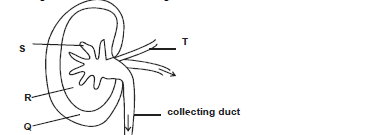
a) Name the organ.
b) Identify the parts R and S.
c) i) State three differences in the structure above found in the desert rat and fish.
ii) Account for the differences stated above.
(d) Name the gland associated with the secretion of aldosterone hormone.
Date posted:
May 27, 2019
.
Answers (1)
-
The diagram below is a cross section of a portion of alimentary canal.
a) i) Which part of the alimentary canal is represented by the portion...
(Solved)
The diagram below is a cross section of a portion of alimentary canal.

a) i) Which part of the alimentary canal is represented by the portion above.
ii) Give a reason for your answer in (a) (i) above.
b) i) State two functions of the part of alimentary canal represented above.
ii) Explain two structural adaptations of the part of alimentary canal represented above.
Date posted:
May 27, 2019
.
Answers (1)
-
The colour of tips of hair in Shepherd dog is controlled by a gene with three alleles B for Black, R for red and C...
(Solved)
The colour of tips of hair in Shepherd dog is controlled by a gene with three alleles B for Black, R for red and C for copper.
A cross between pure breeding red and copper hair tips produce offsprings with scarlet hair tips. Crossing pure breeding
red and black hair tips yields all red offsprings. A cross between pure breeds of copper and black produce offsprings that
are all copper.
a) Comment on the inheritance of the three alleles B, R and C.
b) A dog breeder wishes to know the genotype of a dog with red hair tips. State and explain the cross needed to determine
the dog’s genotype.
c) A mother of blood group AB was married to a man of blood group B heterozygous. What is the probability that one of
their sons would be blood group A? Show your working.
Date posted:
May 27, 2019
.
Answers (1)
-
Give three types of movable joints found in mammalian skeleton.
(Solved)
Give three types of movable joints found in mammalian skeleton.
Date posted:
May 27, 2019
.
Answers (1)
-
Distinguish between exocrine and endocrine glands.
(Solved)
Distinguish between exocrine and endocrine glands.
Date posted:
May 27, 2019
.
Answers (1)
-
What is the significance of the high tail power in fish locomotion.
(Solved)
What is the significance of the high tail power in fish locomotion.
Date posted:
May 27, 2019
.
Answers (1)
-
The length from tail tip to the anus in a fish is 8cm whereas that from tail tip is 24cm. Calculate the tail power of...
(Solved)
The length from tail tip to the anus in a fish is 8cm whereas that from tail tip is 24cm. Calculate the tail power of the fish.
Date posted:
May 27, 2019
.
Answers (1)
-
The diagram below represents a young root and four cells which occur in different regions of the root tip labelled K, L, M
and N.
State the...
(Solved)
The diagram below represents a young root and four cells which occur in different regions of the root tip labelled K, L, M
and N.
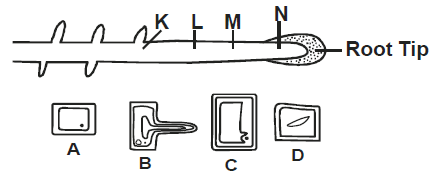
State the regions of the root tip where each of the cells A B C D occur.
Date posted:
May 27, 2019
.
Answers (1)
-
List two possible effects that are likely to occur if the maternal and foetal circulatory system were directly connected.
(Solved)
List two possible effects that are likely to occur if the maternal and foetal circulatory system were directly connected.
Date posted:
May 27, 2019
.
Answers (1)
-
The diagram below represents an organism.
i) Name the kingdom to which the organism belong.
ii) Give a reason for your answer in a (i) above.
(Solved)
The diagram below represents an organism.
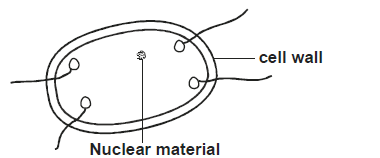
i) Name the kingdom to which the organism belong.
ii) Give a reason for your answer in a (i) above.
Date posted:
May 27, 2019
.
Answers (1)
-
The table below shows percentage composition of blood plasma and urine from different substances.
Explain why;
i) There are no plasma proteins in the urine.
ii) Urea...
(Solved)
The table below shows percentage composition of blood plasma and urine from different substances.

Explain why;
i) There are no plasma proteins in the urine.
ii) Urea concentration is greater in the urine than in the blood plasma.
iii) There is glucose in the urine
Date posted:
May 27, 2019
.
Answers (1)
-
In an experiment to measure gaseous exchange between flying locust and its surrounding it was found that for every 1cm3 of carbon (IV) oxide,...
(Solved)
In an experiment to measure gaseous exchange between flying locust and its surrounding it was found that for every 1cm3 of carbon (IV) oxide, 1.43cm3 of oxygen was consumed.
a) Calculate the respiratory quotient forthe food substance that was being oxidised.
b) State the importance of respiratory quotient.
Date posted:
May 27, 2019
.
Answers (1)